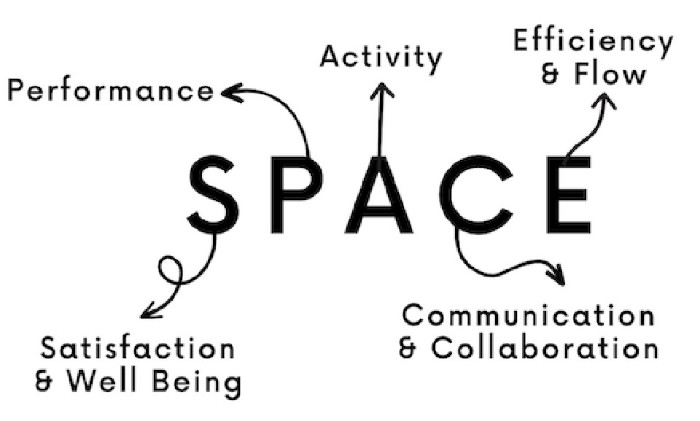SPACE Framework
With the introduction of working from home, organizations began to focus on developer productivity. However, with the complexity of modern development tasks, organizations have started to face challenges in finding a single metric to measure developers’ productivity.
As a solution, the SPACE productivity framework was introduced by Microsoft’s GitHub and researchers from the DevRel team to capture a well-rounded view of developer productivity.
What is the SPACE Framework?
The SPACE framework is a software engineering framework developed to understand and improve developer productivity. It considers five key components:
- Satisfaction and well-being
- Performance
- Activity
- Communication and collaboration
- Efficiency and flow
By combining these five components, the SPACE Framework offers a balanced view of productivity that goes beyond traditional metrics. It enables teams to identify areas for improvement while creating a supportive, sustainable work environment.
SPACE Framework Metrics
Now, let’s get into the details of SPACE framework metrics.
1. Satisfaction and Well-being
- This metric focuses on how happy and fulfilled developers feel about their work, the development process, and the overall work environment.
- If the developers are satisfied with the work, process, and environment, they tend to be more productive and more motivated to complete the tasks, which results in a high retention rate.
- Work-life balance, learning opportunities, and recognition are some of the factors that will make the employees happy.
- To measure this metric, organizations can use regular surveys, feedback sessions, and one-on-one meetings to understand developer concerns and levels of engagement.
- Metrics such as employee satisfaction scores, well-being index, and retention rates provide a tangible way to track this dimension.
2. Performance
- This metric focuses on the developer’s performance. It is assessed by the deliverables of the project, focusing more on the quality of work rather than the quantity.
- Work should be completed within the given timeline, and there should not be any bugs. Furthermore, code should not contain any code smells, vulnerabilities, or security threats.
- High performance is critical to understanding that a team’s output aligns with the organization’s goals and customer needs.
- To measure performance, organizations can use code reviews, production bug counts (e.g., tracked in JIRA), and code quality tools like SonarQube for tracking code smells and vulnerabilities.
- Organizations can use metrics like bug frequency, customer satisfaction related to software performance, and frequency of critical issues to measure performance.
3. Activity
- While performance focuses more on quality, activity focuses more on quantity.
- This metric measures the number of activities completed by developers. This can include completed tasks, commits, code reviews, and other quantifiable actions.
- While this metric doesn’t directly indicate developer productivity, it can identify issues, risks, or overwork and help project managers plan and mitigate them.
- Tools like GitLab, GitHub, or project management software can provide insight into activity levels by tracking commits, pull requests, and completed tasks.
- Metrics like sprint completion rates and Agile reports (e.g., burndown charts) help understand activity trends.
4. Communication and Collaboration
- This metric focuses on communication and collaboration in the team. It measures how well team members work together, share information, and solve problems.
- Poor collaboration can lead to misunderstandings and duplicate work, resulting in many dependencies and delaying project timelines.
- To improve communication and collaboration, daily scrum meetings, grooming sessions, and sprint retrospective sessions can be conducted physically or through communication tools like MS Teams, Slack, and Skype.
- Organizations can measure communication effectiveness through metrics like time spent on code reviews, onboarding time for new members, and frequency of cross-team interactions.
5. Efficiency and Flow
- This metric focuses on how developers can work without interruptions and how much time they spend in a focused, productive state.
- High efficiency means that developers are able to work in a focused way, which often leads to faster delivery and high-quality output. Without interruptions, developers can stay in a particular chain of thought and complete the work more quickly.
- Organizations can use metrics such as feature delivery cycle times, lead time for bug fixes, deployment frequency, and deployment success rate to measure efficiency and flow.
Importance of using the Space Framework
The SPACE framework for developer productivity is important because it provides a well-rounded way to evaluate and enhance developer productivity. Rather than focusing solely on output or deadlines, SPACE emphasizes a balanced view of productivity that considers both immediate results and long-term developer well-being.
Here’s why the SPACE Framework is essential:
- Encourages teams to consider well-being alongside productivity metrics.
- Takes a well-rounded approach by evaluating satisfaction, performance, activity, communication & collaboration, and efficiency.
- Helps teams work together more effectively, reducing misunderstandings and preventing duplicated efforts.
- Provides clear metrics for each component, allowing for the effective prioritization of resources.
- Promotes a positive work environment, leading to higher retention and engagement.
Conclusion
The SPACE framework provides a more fulfilling framework for identifying developer productivity rather than focusing on single metrics. By focusing on satisfaction, performance, activity, communication, collaboration, efficiency, and flow, the framework provides an overall view that supports both team well-being and productivity.
Adopting SPACE not only helps improve productivity but also helps build a solid team and reduce employee retention. Organizations that prioritize the SPACE framework are likely to be more successful and sustainable, resulting in effective development teams, high-quality software, and greater employee satisfaction. Implementing this framework may require time and effort, but the benefits for teams and organizations make it worth the investment.


